[English] 日本語
 Yorodumi
Yorodumi- EMDB-20452: Cryo-EM structure of HzTransib/intact TIR substrate DNA pre-react... -
+ Open data
Open data
- Basic information
Basic information
| Entry | Database: EMDB / ID: EMD-20452 | |||||||||
|---|---|---|---|---|---|---|---|---|---|---|
| Title | Cryo-EM structure of HzTransib/intact TIR substrate DNA pre-reaction complex (PRC) | |||||||||
 Map data Map data | ||||||||||
 Sample Sample |
| |||||||||
 Keywords Keywords | RAG-like transposase / DDE family enzyme / Transib / Terminal inverted repeat. / RECOMBINATION / recombination-dna complex | |||||||||
| Function / homology | metal ion binding / Putative DNA-mediated transposase Function and homology information Function and homology information | |||||||||
| Biological species |  Helicoverpa zea (corn earworm) Helicoverpa zea (corn earworm) | |||||||||
| Method | single particle reconstruction / cryo EM / Resolution: 3.4 Å | |||||||||
 Authors Authors | Liu C / Schatz DG / Yang Y | |||||||||
| Funding support |  United States, 1 items United States, 1 items
| |||||||||
 Citation Citation |  Journal: Nature / Year: 2019 Journal: Nature / Year: 2019Title: Structures of a RAG-like transposase during cut-and-paste transposition. Authors: Chang Liu / Yang Yang / David G Schatz /  Abstract: Transposons have had a pivotal role in genome evolution and are believed to be the evolutionary progenitors of the RAG1-RAG2 recombinase, an essential component of the adaptive immune system in jawed ...Transposons have had a pivotal role in genome evolution and are believed to be the evolutionary progenitors of the RAG1-RAG2 recombinase, an essential component of the adaptive immune system in jawed vertebrates. Here we report one crystal structure and five cryo-electron microscopy structures of Transib, a RAG1-like transposase from Helicoverpa zea, that capture the entire transposition process from the apo enzyme to the terminal strand transfer complex with transposon ends covalently joined to target DNA, at resolutions of 3.0-4.6 Å. These structures reveal a butterfly-shaped complex that undergoes two cycles of marked conformational changes in which the 'wings' of the transposase unfurl to bind substrate DNA, close to execute cleavage, open to release the flanking DNA and close again to capture and attack target DNA. Transib possesses unique structural elements that compensate for the absence of a RAG2 partner, including a loop that interacts with the transposition target site and an accordion-like C-terminal tail that elongates and contracts to help to control the opening and closing of the enzyme and assembly of the active site. Our findings reveal the detailed reaction pathway of a eukaryotic cut-and-paste transposase and illuminate some of the earliest steps in the evolution of the RAG recombinase. | |||||||||
| History |
|
- Structure visualization
Structure visualization
| Movie |
 Movie viewer Movie viewer |
|---|---|
| Structure viewer | EM map:  SurfView SurfView Molmil Molmil Jmol/JSmol Jmol/JSmol |
| Supplemental images |
- Downloads & links
Downloads & links
-EMDB archive
| Map data |  emd_20452.map.gz emd_20452.map.gz | 59.9 MB |  EMDB map data format EMDB map data format | |
|---|---|---|---|---|
| Header (meta data) |  emd-20452-v30.xml emd-20452-v30.xml emd-20452.xml emd-20452.xml | 18.5 KB 18.5 KB | Display Display |  EMDB header EMDB header |
| Images |  emd_20452.png emd_20452.png | 306.6 KB | ||
| Filedesc metadata |  emd-20452.cif.gz emd-20452.cif.gz | 7 KB | ||
| Archive directory |  http://ftp.pdbj.org/pub/emdb/structures/EMD-20452 http://ftp.pdbj.org/pub/emdb/structures/EMD-20452 ftp://ftp.pdbj.org/pub/emdb/structures/EMD-20452 ftp://ftp.pdbj.org/pub/emdb/structures/EMD-20452 | HTTPS FTP |
-Validation report
| Summary document |  emd_20452_validation.pdf.gz emd_20452_validation.pdf.gz | 563.5 KB | Display |  EMDB validaton report EMDB validaton report |
|---|---|---|---|---|
| Full document |  emd_20452_full_validation.pdf.gz emd_20452_full_validation.pdf.gz | 563 KB | Display | |
| Data in XML |  emd_20452_validation.xml.gz emd_20452_validation.xml.gz | 6 KB | Display | |
| Data in CIF |  emd_20452_validation.cif.gz emd_20452_validation.cif.gz | 6.8 KB | Display | |
| Arichive directory |  https://ftp.pdbj.org/pub/emdb/validation_reports/EMD-20452 https://ftp.pdbj.org/pub/emdb/validation_reports/EMD-20452 ftp://ftp.pdbj.org/pub/emdb/validation_reports/EMD-20452 ftp://ftp.pdbj.org/pub/emdb/validation_reports/EMD-20452 | HTTPS FTP |
-Related structure data
| Related structure data |  6pqrMC 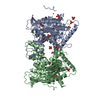 6pqnC  6pquC  6pqxC  6pqyC  6pr5C C: citing same article ( M: atomic model generated by this map |
|---|---|
| Similar structure data |
- Links
Links
| EMDB pages |  EMDB (EBI/PDBe) / EMDB (EBI/PDBe) /  EMDataResource EMDataResource |
|---|
- Map
Map
| File |  Download / File: emd_20452.map.gz / Format: CCP4 / Size: 64 MB / Type: IMAGE STORED AS FLOATING POINT NUMBER (4 BYTES) Download / File: emd_20452.map.gz / Format: CCP4 / Size: 64 MB / Type: IMAGE STORED AS FLOATING POINT NUMBER (4 BYTES) | ||||||||||||||||||||||||||||||||||||||||||||||||||||||||||||||||||||
|---|---|---|---|---|---|---|---|---|---|---|---|---|---|---|---|---|---|---|---|---|---|---|---|---|---|---|---|---|---|---|---|---|---|---|---|---|---|---|---|---|---|---|---|---|---|---|---|---|---|---|---|---|---|---|---|---|---|---|---|---|---|---|---|---|---|---|---|---|---|
| Projections & slices | Image control
Images are generated by Spider. | ||||||||||||||||||||||||||||||||||||||||||||||||||||||||||||||||||||
| Voxel size | X=Y=Z: 1.05 Å | ||||||||||||||||||||||||||||||||||||||||||||||||||||||||||||||||||||
| Density |
| ||||||||||||||||||||||||||||||||||||||||||||||||||||||||||||||||||||
| Symmetry | Space group: 1 | ||||||||||||||||||||||||||||||||||||||||||||||||||||||||||||||||||||
| Details | EMDB XML:
CCP4 map header:
| ||||||||||||||||||||||||||||||||||||||||||||||||||||||||||||||||||||
-Supplemental data
- Sample components
Sample components
-Entire : Pre-reaction complex of HzTransib with intact TIR substrate DNA
| Entire | Name: Pre-reaction complex of HzTransib with intact TIR substrate DNA |
|---|---|
| Components |
|
-Supramolecule #1: Pre-reaction complex of HzTransib with intact TIR substrate DNA
| Supramolecule | Name: Pre-reaction complex of HzTransib with intact TIR substrate DNA type: complex / ID: 1 / Parent: 0 / Macromolecule list: #1-#3 |
|---|---|
| Source (natural) | Organism:  Helicoverpa zea (corn earworm) Helicoverpa zea (corn earworm) |
-Macromolecule #1: DNA-mediated transposase
| Macromolecule | Name: DNA-mediated transposase / type: protein_or_peptide / ID: 1 / Number of copies: 2 / Enantiomer: LEVO |
|---|---|
| Source (natural) | Organism:  Helicoverpa zea (corn earworm) Helicoverpa zea (corn earworm) |
| Molecular weight | Theoretical: 56.582734 KDa |
| Recombinant expression | Organism:  |
| Sequence | String: KPAPSTIFSP EKALGLLLSL KLSKWQYITL RETTIREGSK EIYPSYYKVQ KAKLQCYPPK AFVAVTDSSA KIALQALLDL TVNRIFETI RSPDAIQNKQ LILISKWGFD GASNQSRYKQ NIESGQGDSS IFMTSLVPLK LTADGDTVWV NPKPCSPMYC R PVQFSFVK ...String: KPAPSTIFSP EKALGLLLSL KLSKWQYITL RETTIREGSK EIYPSYYKVQ KAKLQCYPPK AFVAVTDSSA KIALQALLDL TVNRIFETI RSPDAIQNKQ LILISKWGFD GASNQSRYKQ NIESGQGDSS IFMTSLVPLK LTADGDTVWV NPKPCSPMYC R PVQFSFVK ETKDVVINEK TAMDDEIEAL VPSKCQGHEI SHKLMMTMID GKICTYLSEA KSNAACYLCL AKPTEMSKLD VI ASKTISS GVYEFGLSTL HARINVMECL LHIAYRLDFK KWSARGEGHQ ELLHSRKKLI QDRFKDDLNL LIDIVKQGSG TTN DGNTAR RFFEFPDKTA AITGLDEDLI RRFSVILQAI TSGEIIDVPK FKEYARTTAE KYVELYDWYY MSSTVHKLLI HGGD IIAEN AIVPIGSLSE EASEARNKDF RRFREHHSRK KSRQASNEDI LNMLIISSDP LISFTRPKLD AHKRQTYFKE TVELL QLQD QEAPTEFHHH HHH UniProtKB: Putative DNA-mediated transposase |
-Macromolecule #2: DNA (5'-D(*CP*TP*AP*GP*AP*TP*CP*TP*CP*AP*CP*GP*GP*TP*GP*GP*AP*TP*...
| Macromolecule | Name: DNA (5'-D(*CP*TP*AP*GP*AP*TP*CP*TP*CP*AP*CP*GP*GP*TP*GP*GP*AP*TP*CP*GP*AP*AP*AP*A)-3') type: dna / ID: 2 / Number of copies: 2 / Classification: DNA |
|---|---|
| Source (natural) | Organism:  Helicoverpa zea (corn earworm) Helicoverpa zea (corn earworm) |
| Molecular weight | Theoretical: 7.402806 KDa |
| Sequence | String: (DC)(DT)(DA)(DG)(DA)(DT)(DC)(DT)(DC)(DA) (DC)(DG)(DG)(DT)(DG)(DG)(DA)(DT)(DC)(DG) (DA)(DA)(DA)(DA) |
-Macromolecule #3: DNA (5'-D(P*TP*TP*TP*TP*CP*GP*AP*TP*CP*CP*AP*CP*CP*GP*TP*GP*AP*GP...
| Macromolecule | Name: DNA (5'-D(P*TP*TP*TP*TP*CP*GP*AP*TP*CP*CP*AP*CP*CP*GP*TP*GP*AP*GP*AP*TP*CP*TP*AP*G)-3') type: dna / ID: 3 / Number of copies: 2 / Classification: DNA |
|---|---|
| Source (natural) | Organism:  Helicoverpa zea (corn earworm) Helicoverpa zea (corn earworm) |
| Molecular weight | Theoretical: 7.33574 KDa |
| Sequence | String: (DT)(DT)(DT)(DT)(DC)(DG)(DA)(DT)(DC)(DC) (DA)(DC)(DC)(DG)(DT)(DG)(DA)(DG)(DA)(DT) (DC)(DT)(DA)(DG) |
-Macromolecule #4: MAGNESIUM ION
| Macromolecule | Name: MAGNESIUM ION / type: ligand / ID: 4 / Number of copies: 2 / Formula: MG |
|---|---|
| Molecular weight | Theoretical: 24.305 Da |
-Macromolecule #5: ZINC ION
| Macromolecule | Name: ZINC ION / type: ligand / ID: 5 / Number of copies: 2 / Formula: ZN |
|---|---|
| Molecular weight | Theoretical: 65.409 Da |
-Macromolecule #6: POTASSIUM ION
| Macromolecule | Name: POTASSIUM ION / type: ligand / ID: 6 / Number of copies: 2 / Formula: K |
|---|---|
| Molecular weight | Theoretical: 39.098 Da |
-Experimental details
-Structure determination
| Method | cryo EM |
|---|---|
 Processing Processing | single particle reconstruction |
| Aggregation state | particle |
- Sample preparation
Sample preparation
| Concentration | 0.3 mg/mL | |||||||||||||||
|---|---|---|---|---|---|---|---|---|---|---|---|---|---|---|---|---|
| Buffer | pH: 7.5 Component:
Details: Solutions were made fresh from concentrated and filtered to avoid microbial contamination. | |||||||||||||||
| Grid | Model: Quantifoil R1.2/1.3 / Material: GOLD / Mesh: 300 / Support film - Material: CARBON / Support film - topology: HOLEY / Pretreatment - Type: GLOW DISCHARGE / Pretreatment - Time: 10 sec. | |||||||||||||||
| Vitrification | Cryogen name: ETHANE / Chamber humidity: 100 % / Chamber temperature: 296 K / Instrument: FEI VITROBOT MARK IV / Details: Blot for 3 seconds before plunging. | |||||||||||||||
| Details | Recombinantly expressed HzTransib transposase was mixed with chemically synthesized TIR substrate DNA. The complex was further purified on size-exclusion chromatography column. The final complex was monodisperse. |
- Electron microscopy
Electron microscopy
| Microscope | FEI TITAN KRIOS |
|---|---|
| Specialist optics | Energy filter - Name: GIF Quantum LS / Energy filter - Slit width: 20 eV |
| Details | Preliminary grid screening was performed manually. |
| Image recording | Film or detector model: GATAN K2 SUMMIT (4k x 4k) / Detector mode: SUPER-RESOLUTION / Digitization - Frames/image: 1-40 / Average electron dose: 50.8 e/Å2 Details: Images were collected in movie-mode at 5 frames per second. |
| Electron beam | Acceleration voltage: 300 kV / Electron source:  FIELD EMISSION GUN FIELD EMISSION GUN |
| Electron optics | Illumination mode: FLOOD BEAM / Imaging mode: BRIGHT FIELD / Cs: 2.7 mm / Nominal defocus max: 2.4 µm / Nominal defocus min: 1.4000000000000001 µm / Nominal magnification: 130000 |
| Sample stage | Specimen holder model: FEI TITAN KRIOS AUTOGRID HOLDER / Cooling holder cryogen: NITROGEN |
| Experimental equipment |  Model: Titan Krios / Image courtesy: FEI Company |
+ Image processing
Image processing
-Atomic model buiding 1
| Initial model | PDB ID: Chain - Chain ID: A / Chain - Residue range: 21-501 / Chain - Source name: PDB / Chain - Initial model type: experimental model |
|---|---|
| Details | Initial local fitting was done using UCSF Chimera, then manually adjusted and rebuilt in Coot. Final model was refined using Phenix real-space refinement. |
| Refinement | Space: REAL / Protocol: RIGID BODY FIT / Target criteria: Correlation coefficient |
| Output model |  PDB-6pqr: |
 Movie
Movie Controller
Controller







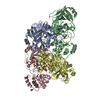
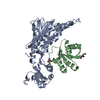

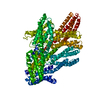

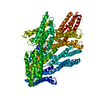


 Z (Sec.)
Z (Sec.) Y (Row.)
Y (Row.) X (Col.)
X (Col.)





















